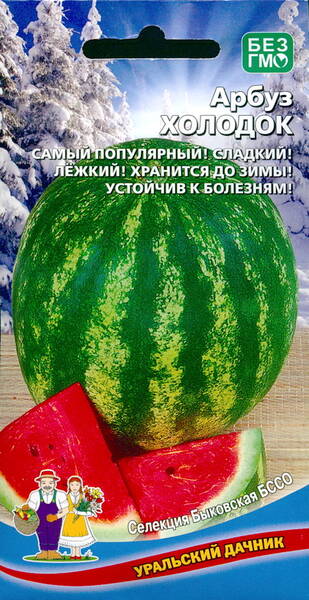Immerse yourself in a world of refreshing sweetness with "Kholodok" watermelon! This variety is a true gift for those who appreciate excellent taste and the ability to enjoy a summer treat even in the coldest months. Imagine: snow outside, and on your table is a juicy, fragrant watermelon, like a slice of sunshine on a winter day. With "Kholodok" it's possible!
Large and sweet. Stores well into winter. These are the words that best describe this wonderful variety. "Kholodok" isn't just a watermelon; it's your chance to extend summer!
Main characteristics of the "Kholodok" variety:
- Type: Mid-season
- Ripening period: 95-100 days from sowing or 60-75 days from germination
- Fruit shape: Elongated-spherical, weakly segmented
- Fruit color: Green with black-green stripes
- Fruit weight: 5-8 kg
- Flesh color: Bright pink
- Flesh taste: Sweet with a little sourness, excellent
- Yield: 15-18 kg per plant
Technical specifications:
The "Kholodka" plant is vigorous, with long vines, allowing it to effectively utilize sunlight to enhance its sweetness. The bark is thick and dense, ensuring easy transport and a long shelf life —up to 3-5 months! This means you can harvest in the fall and enjoy fresh watermelon practically all winter long.
The flesh of the "Kholodok" watermelon is a true delight. Bright pink, densely grained, juicy, and incredibly sweet, with a subtle, subtle tartness, it perfectly quenches thirst and provides a boost of energy. The seeds are large and light brown.
Features of cultivation and use:
The "Kholodok" variety is resistant to anthracnose, powdery mildew, and fusarium , making it much easier to grow and allowing for a bountiful harvest even in unfavorable conditions. It's recommended for fresh consumption. Imagine how pleasant it will be to surprise your family and friends by offering them a fresh, juicy watermelon in the dead of winter!
Growing the "Kholodok" watermelon isn't just gardening; it's creating a little miracle that will delight you and your loved ones with its unique taste and aroma. Treat yourself to this amazing variety and experience the true flavor of summer!
Order the "Kholodok" watermelon now and experience the full delight of this large, sweet, and long-lasting variety!
* An effective method for obtaining early watermelon production is the seedling method.
Thanks to the jump-start in plant development achieved by growing seedlings this way, the first fruits can be harvested 10 to 20 days earlier than when sowing seeds directly into the ground. This increases the early yield severalfold, significantly increasing the overall fruit yield.
Watermelon seedlings are grown in semi-warm, early-season greenhouses or plastic hothouses as a second crop after green vegetables or early cabbage seedlings. They can also be grown indoors, on windowsills and balconies.
Seedlings are grown in nutrient pots of the same composition as those used for vegetable crops, in 8x8 or 10x10 cm paper cups. Seedlings are 30-35 days old (from germination). Water the seedlings generously before planting, and add water to the holes as they are planted. Planting follows the same pattern as sowing seeds directly into the ground. Subsequent care for transplanted plants is the same as for seeded plants.
Fruit harvesting.
Watermelons are typically harvested as they ripen. Those intended for long-distance transport are harvested a few days before they are fully ripe, while those used locally and for seed production are harvested when they are fully ripe. The final, complete harvest of ripe fruits promotes better growth and ripening of the remaining fruits. Therefore, delaying (or rushing) the harvest is unavoidable.
Experienced melon growers determine the ripeness of watermelons visually by their appearance. As they ripen, the bark develops a characteristic sheen and elasticity characteristic of each variety, the bark color and pattern become clear, and a yellow spot forms on the area of bark lying on the ground. The stem and tendril near it dry out as the fruit ripens. When a ripe watermelon is struck with the palm of the hand or flicked, it produces a dull sound, and when squeezed (which is not recommended), the flesh crackles.
Placement of crops.
Watermelon (like other melons) yields best results when sown on virgin or fallow land or after perennial grasses, which are their best predecessors. In garden plots (especially in areas with insufficient heat), watermelon should be planted in sunny areas with a south, southeast, or southwest-facing slope. It can also be grown in greenhouses and between rows of young orchards, not shaded by garden plantings.
Application of fertilizers.
A combination of mineral and organic fertilizers is most effective. The best organic fertilizers for watermelon are last year's rotted manure or compost. Fresh manure, especially in large doses, impairs the fruit's flavor and weakens the plant's resistance to disease. It is only practical to apply it to watermelon in small plots in northern growing regions, where it is used not so much as a fertilizer as to insulate the soil and enrich the soil and air with carbon dioxide, thereby improving the microclimate. In this case, manure is applied in the spring to pre-dug furrows or pits (fallow), then covered with soil to a depth of 10-15 cm, or 15-20 cm in fallow pits.
Watermelon seeds are sown sideways along the furrows or in the center of the fallow pit. You can create beds 210-270 cm wide, apply manure and incorporate it into a furrow in the center of the bed (lengthwise), and sow two rows of watermelon on each side of the incorporate-manure furrow. The row spacing within the bed is 70-90 cm, and the spacing between rows on adjacent beds is 140-180 cm. Using these methods, manure consumption is approximately 6-8 kg per square meter.
The best mineral fertilizers for watermelon include superphosphate, ammonium nitrate, and potassium salt. It's important to note that excessive nitrogen fertilizers negatively impact the taste and nutritional value of watermelon, specifically leading to the accumulation of nitrates, which are harmful to humans. Therefore, it's best not to overuse nitrogen, or any other fertilizer, especially during the fruiting period.












